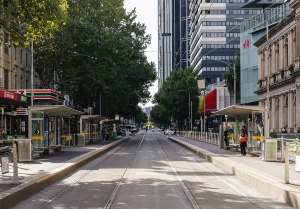When coronavirus forced me to home-school my daughter, learning through play was the answer we both needed
By Rachel Parker
Posted Monday 27 April 2020

Like many children across Australia, my daughter greeted the prospect of schooling from home, or “Mummy School”, as I called it, with tears which escalated into screaming.
My teenager emerged from her bedroom, direct from her morning online class, yelling, “Shut up!” to all household members. “You shut up!” Lila responded.
It was on.
“We have to get out of here right now,” I thought.
I grabbed the child and the dog and we went for a walk to the park. As we walked, I thought about what I knew about teaching and learning, and what role I could play here.
For the past two years I’ve been conducting research at ACER for the LEGO Foundation about learning through play. Surely I could try some of the things I have been reading, observing, discussing?
I felt like the understudy — actually, more like the lighting manager — who had been shoved onto the stage after the whole cast fell ill … for the entire season. I was terrified.
A light-bulb moment
As we walked in the sunshine I noticed a swarm of little flying bugs above the wet grass. “What are they? Do they bite? Let’s take a picture and look them up when we get home,” Lila said.
We passed dogs who sniffed our dog, Yoyo. “What kind of dog is that? Do they shed?” Lila asked of the owner.
We went to Lila’s “secret park”, where a truck rolled in with barrels of what appeared to be chemicals and spray guns.
“I wonder what they are doing?” I said aloud. Lila responded: “I think they are spraying because of coronavirus.”

We approached the truck and from a safe distance and saw they were spraying steam into the bark on the playground floor. We talked about this, and after throwing the ball to Yoyo a few more times, we decided to go home.
As we walked home I thought about the things we observed and the questions Lila asked. There was definitely something here. All the lights on my learning through play “switchboard” were igniting.
If I could just remain engaged, listen carefully, ask helpful questions at the right time, and provide answers when they were needed, we might be okay.
Duplicating a school day felt hard
At this point you are probably wondering about Lila’s school.
She attends a local government primary school here in Victoria, where staff have been hastily working to understand the directions from the Department of Education, their obligations to the school community, and responsibilities to students, in this state of emergency.

We received a series of emails on the day before school was meant to resume with attachments including a draft schedule, a series of proposed activities to be conducted over the week, a description of the role of parents and carers, website logins, and what to expect from the teacher.
It appeared we were to download and read this information, make sense of it, set up a schedule, and “play teacher”.
There were no scheduled online meetings with the teacher or class as yet.
But serving jam toast became a learning experience
When we arrived home, Lila showed me her cafe. She had watched a YouTube video over the holidays about a girl who had set up a Starbucks in her driveway as she was no longer able to visit her favourite cafe.
I noticed the paper stuck to the outside of the kitchen window and stopped to read it. It was a menu with prices. She donned an apron and told me to stand outside near the open sliding window and make my order.
With a professional demeanour, Lila flipped open her notepad and took down my request for a skinny latte and jam toast.

She calculated the price and told me to take a seat in the backyard and she would bring out my food. She had set up the cafe for limited physical contact — coronavirus friendly.
During the course of the afternoon, Lila engaged me as an employee/servant/cleaner/IT helpdesk.
She decided the outfit required a slick new look, so we took photos of food and drinks we prepared at home, and I showed her how to send them to email and drop them into Word.
Lila named, typed and priced the new items, learning how to use a number of Word functions. We discussed competitive pricing, discounts, and what we would do with the income.
She wanted to donate the profits to a hospital for masks.
We also talked about income and profit, expenses and operating costs. We watched a video on decimals, fractions and percentages so she could learn how to work out a discount for family members.
We filled glasses as props for converting fractions. We created signs for customers and I wrote a review of the cafe, which Lila then read and tacked to the kitchen wall.
We nailed year 4 curriculum
After dinner I sat down, opened my computer and read the Week One Learning Schedule.
Literacy: 60 minutes. Recess: half an hour. Numeracy: 40 minutes. Lunch: one hour. Physical activity: 30 minutes. Additional curriculum: 90 minutes.
I don’t think we would have been able to implement this type of structured schedule, particularly with Lila feeling as she did at the start of the day.
So I clicked on the Australian Curriculum website.
Year 4 Mathematics: “Fractions and decimals: investigate equivalent fractions, used in context”.
YEar 4 English: “Creating texts: Using a range of software including word processing programs to construct, edit and publish written text, and select and place visual, print and audio elements”.
I think we covered it.
What does learning really look like?
At one point during the activity, Lila wanted to involve her sister. She requested her order via text and the teenager emerged and started to play, proposing curious names for the dishes.
The teenager then turned to me and said, “Mum, this isn’t real learning. Lila is missing school — you have to make sure that she doesn’t fall behind.”
The teenager, like so many adults and children, has formed a specific view of what learning looks like — quiet, solitary toil on specific skill areas.
This is a really tough time for parents, carers, and children. Children are responding differently to the closure of their school and changes to their education.
Parents and carers have varying levels of resources, knowledge and time available to support learning at home, and different kinds of support and resources from their children’s school.
It is my hope that this short piece might be useful for those who feel overwhelmed, like I did, to remind us how we might use parts of our ordinary lives as the canvas to paint a simple picture of learning through play at home.
Rachel Parker is a senior research fellow for education and development at the Australian Council for Educational Research (ACER).








